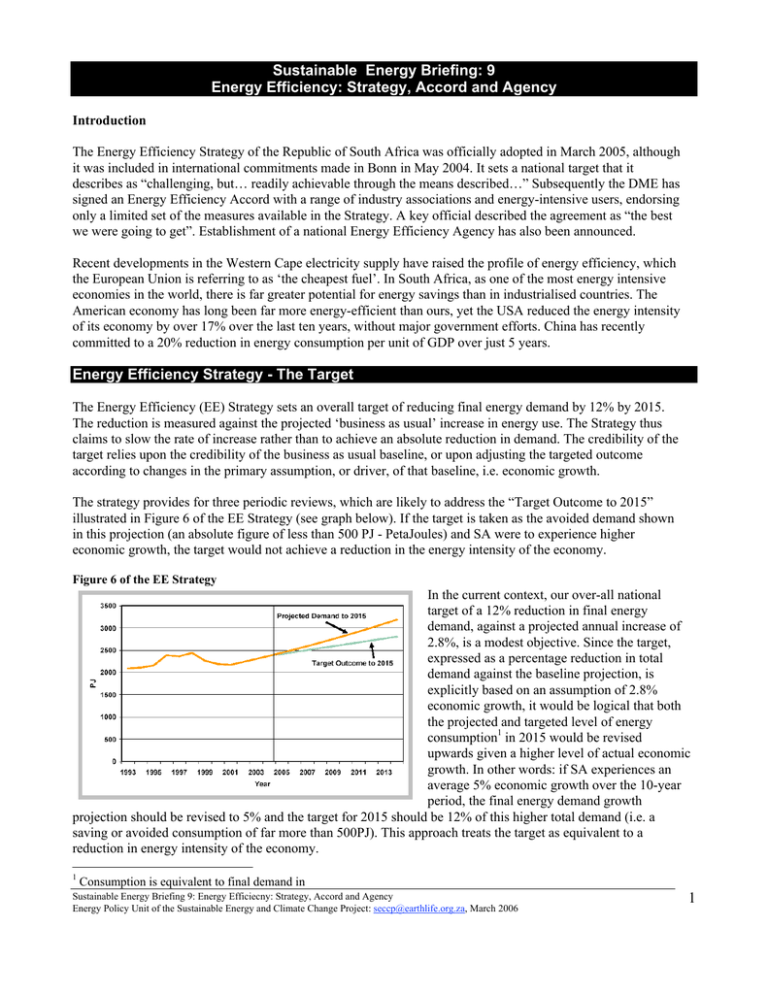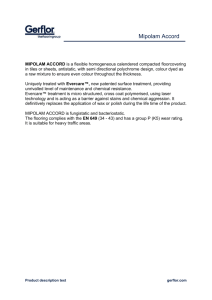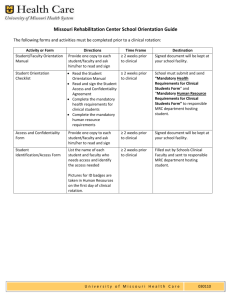Sustainable Energy Briefing: 9 Energy Efficiency: Strategy, Accord and Agency
advertisement

Sustainable Energy Briefing: 9 Energy Efficiency: Strategy, Accord and Agency Introduction The Energy Efficiency Strategy of the Republic of South Africa was officially adopted in March 2005, although it was included in international commitments made in Bonn in May 2004. It sets a national target that it describes as “challenging, but… readily achievable through the means described…” Subsequently the DME has signed an Energy Efficiency Accord with a range of industry associations and energy-intensive users, endorsing only a limited set of the measures available in the Strategy. A key official described the agreement as “the best we were going to get”. Establishment of a national Energy Efficiency Agency has also been announced. Recent developments in the Western Cape electricity supply have raised the profile of energy efficiency, which the European Union is referring to as ‘the cheapest fuel’. In South Africa, as one of the most energy intensive economies in the world, there is far greater potential for energy savings than in industrialised countries. The American economy has long been far more energy-efficient than ours, yet the USA reduced the energy intensity of its economy by over 17% over the last ten years, without major government efforts. China has recently committed to a 20% reduction in energy consumption per unit of GDP over just 5 years. Energy Efficiency Strategy - The Target The Energy Efficiency (EE) Strategy sets an overall target of reducing final energy demand by 12% by 2015. The reduction is measured against the projected ‘business as usual’ increase in energy use. The Strategy thus claims to slow the rate of increase rather than to achieve an absolute reduction in demand. The credibility of the target relies upon the credibility of the business as usual baseline, or upon adjusting the targeted outcome according to changes in the primary assumption, or driver, of that baseline, i.e. economic growth. The strategy provides for three periodic reviews, which are likely to address the “Target Outcome to 2015” illustrated in Figure 6 of the EE Strategy (see graph below). If the target is taken as the avoided demand shown in this projection (an absolute figure of less than 500 PJ - PetaJoules) and SA were to experience higher economic growth, the target would not achieve a reduction in the energy intensity of the economy. Figure 6 of the EE Strategy In the current context, our over-all national target of a 12% reduction in final energy demand, against a projected annual increase of 2.8%, is a modest objective. Since the target, expressed as a percentage reduction in total demand against the baseline projection, is explicitly based on an assumption of 2.8% economic growth, it would be logical that both the projected and targeted level of energy consumption1 in 2015 would be revised upwards given a higher level of actual economic growth. In other words: if SA experiences an average 5% economic growth over the 10-year period, the final energy demand growth projection should be revised to 5% and the target for 2015 should be 12% of this higher total demand (i.e. a saving or avoided consumption of far more than 500PJ). This approach treats the target as equivalent to a reduction in energy intensity of the economy. 1 Consumption is equivalent to final demand in Sustainable Energy Briefing 9: Energy Efficiecny: Strategy, Accord and Agency Energy Policy Unit of the Sustainable Energy and Climate Change Project: seccp@earthlife.org.za, March 2006 1 The overall target is broken down into sectoral targets as shown in table 1. The Strategy gives an estimate of the theoretical potential for energy savings for industry and mining based on a comparison with international best practice, and for commercial buildings based on low and medium cost interventions. Power generation relates to Eskom and includes the efficiency of its generating plant. The Strategy notes that improvements here would require major capital investments. Sector targets are initially voluntary but may be made mandatory at some time in the future. The DME will set up the necessary information systems to monitor progress. Table 1: EE Strategy sectoral reduction targets Sector Target Potential Industry & mining 15% 50% Power generation 15% Commercial & public buildings 15% 25% Residential 10% Transport 9% - Energy Efficiency Strategy - Means of Implementation The Strategy defines a range of generic ‘implementing instruments’ through which the targets will be achieved, which are summarised table 2. It then outlines a programme for each of the sectors except power generation, where energy efficiency “has been the subject of much dialogue between the DME and Eskom” [section 3.3]. Finally it considers cross-cutting issues: integrated energy planning; renewable energy; environment and health; and government’s Cleaner Fuels Programme. Table 2: EE Strategy implementing instruments - Mandatory standards for appliances, vehicles, fuels, housing Support - Mandatory appliance labelling Mechanisms Policy Finance Instruments Stakeholders - Professional certification of energy auditors and inspectors - Education – through schools and relevant professional (architects & engineers etc) and artisan training (plumbers and electricians etc) - Research and technology development & demonstration through the SA National Energy Research Institute - Regulation to secure compliance - Energy audits mandatory for intensive users ‘in due course’ - Energy management systems promoted - Legislation and regulations - Leadership possibly through EE agency - Incentives according to opportunities in fiscal reform process but limited by competing resource needs - Fee bates levied on inefficient vehicles to subsidise efficient vehicles - Budget provision for EE in government buildings - Promote development of private sector Energy Service Companies (ESCOs) - Promote CDM to access technology and supplementary finance - Demand Side Management by utilities with NER regulated targets - Energy pricing to reflect full economic, social and environmental cost - Defining responsibilities of stakeholders including other govt departments - Prompting leadership according to responsibilities The Strategy justifies the modesty of targets as realistic and accounting for the time it takes for consumers to respond. It does not discuss the limitations of the instruments chosen to implement the sectoral programmes, which will be key to what is then counted as realistic. Thus, the “majority of Energy Efficiency improvements will materialise through the implementation of standards, regulation and management tools, which at the end of the day lead to short pay back periods for the individual enterprises, house owners and government” [4.3]. Sustainable Energy Briefing 9: Energy Efficiecny: Strategy, Accord and Agency Energy Policy Unit of the Sustainable Energy and Climate Change Project: seccp@earthlife.org.za, March 2006 2 The Strategy makes a strong case for mandatory measures and regulatory enforcement [4.1], noting that voluntary measures will have little impact in a context of low priced energy. It also appears, with the final financial instrument, to put an end to the cheap energy regime. However, it does not do this, as the Strategy gives no indication of how it will achieve the inclusion of social and environmental costs (which is clearly not provided for in the Electricity Pricing Policy2). The Strategy would need to introduce substantial charges or levies on energy sales to cover these costs. None of the sectoral programmes provide for such charges and the only mandatory measure specified is for energy audits in commercial buildings. Under cross-cutting issues, the document says that the EE Strategy will be incorporated into the NER’s National Integrated Resource Plan and the DME’s Integrated Energy Policy. It also remarks the overlap with renewable energy, commenting that: • Solar water heating in industrial and commercial buildings and houses would reduce demand equivalent to three medium power stations; • Thermally efficient housing would similarly reduce the need for power (and the document claims that the Department of Housing is ‘re-appraising’ RDP housing standards). • Regenerative braking systems should be part of a review of renewable fuels in the transport sector. Cross-cutting environment and health issues focus on government programmes to reduce indoor pollution through improved woodstoves and low smoke fuels. The Cleaner Fuels Programme is about phasing out lead in petrol and reducing the sulphur content in petrol and diesel. The Energy Efficiency Accord The EE Accord contains undertakings by both business and government, but it is hard to see what government gains by entering into this agreement. The private sector parties agree to a number of actions and practices, in very general terms, that are certainly desirable, but make good business sense in there own right and should be common practice. These include agreement to: “promote the development of sector specific strategies and targets…; develop common reporting requirements… [and] where appropriate, exploit opportunities presented by energy efficiency projects to develop CDM projects.” Government, on the other hand, appears to be restricting itself to encouraging and facilitating voluntary measures while giving up the powers provided for in the national Strategy. “The parties agree to cooperate to pursue the national energy efficiency targets on a voluntary basis…” The DME further agrees to “develop strategies, including the provision of fiscal and other incentives with signatories to incentivise the achievement the achievement of agreed sectoral targets…” The most specific undertaking by each industry signatory is to develop “a specific energy efficiency strategy within one year of signing this Accord.” The Energy Efficiency Agency Government committed to the establishment of an energy efficiency agency in the Declaration adopted at the National Climate Change Conference in October 2005. The success of such institutions internationally is noted in the White Paper on Energy Policy (1998). The prospect of a dedicated institution to promote and facilitate efficiency was greeted with enthusiasm and should be of great value to the emerging, but often struggling, Energy Service Companies (ESCOs), currently supported through Eskom. Effective energy efficiency agencies are typically independent institutions with authority to collect or access information, operate fiscal incentives and provide services, such as energy auditing or oversight of energy service company contracts, at concessionary rates. A common instrument is to charge a small levy on electricity consumption, supplying a fund from which complete refunds can be accessed to finance efficiency measures. The entity seeking the rebate may be required to show that the interventions have a pay-back period of more 2 The Electricity Pricing Policy dated 5 April 2004 is, according to a DME official, still considered to be a draft policy. Sustainable Energy Briefing 9: Energy Efficiecny: Strategy, Accord and Agency Energy Policy Unit of the Sustainable Energy and Climate Change Project: seccp@earthlife.org.za, March 2006 3 than, say, three years and/or go beyond compliance with minimum standards, but will also learn more about the scope for improvements through the process of qualifying for the rebate. Minister Hendricks has announced that a directive has been signed to establish the agency as a division of the Central Energy Fund (CEF) in April 2006. Given that the National Energy Bill is still being amended (officials are not clear whether it will go straight to parliament or be subject to a further round of public comment once the amendments have been approved by cabinet) the mandate and powers of an independent agency could be elaborated in this legislation. Conclusion: The rate of energy use per unit of GDP is a coarse measure of efficiency that does not recognise the high efficiency of many subsistence activities. According to Energy Outlook 2002 (produced by DME, Eskom and UCT, figures for 2000) residential consumption is only 9% of final energy demand, while industrial consumption accounts for 42%. Decisions around the kind of development we prioritise and the foreign direct investment that we provide concessions to attract – given options ranging from community-based bio-fuels production to aluminium smelting3 - will have greater impact on national energy efficiency than any number of compact fluorescent lamps and domestic ripple-meters. There are plentiful opportunities for efficiency gains in the industrial and commercial sectors, many of which will pay for themselves in 2 to 5 years. However, enforcement of mandatory housing standards (e.g. ceilings and substantial walls) and requirements for solar water heating, as well as introduction of a stepped block tariff (see SE Briefing no.1) can deliver major social benefits, not necessarily reflected in formal commercial activity or official economic growth, in addition to reducing energy demand. Such social benefits may not be realised if government prioritises support to business and industry, i.e. they may be an opportunity cost of choosing to facilitate voluntary actions by the private sector instead of introducing mandatory standards. It is widely recognised that energy efficiency agencies need to be independent of institutions with business interests. All players in the energy sector should experience pressure for greater efficiency, including energy conservation, with none being able to contain or constrain the driving agency. Market mechanisms can be combined with enforcement of minimum standards to achieve the broad-ranging benefits of more efficient and productive use of energy, while also reducing the medium and long-term cost of energy. A levy to support both financing of interventions and enforcement of standards would be a way to start “to reflect full economic, social and environmental cost” and achieve the “cost-reflective pricing” called for in the 1998 White Paper. The EE Strategy provides the mandate and the means for assertive implementation that could meet its current targets ahead of schedule. The review process could and should activate mandatory measures to support more ambitious objectives if the “voluntary at present” approach does not scale up with economic growth. The need for efficiency and conservation to be driven (inter alia) by the inclusion of externalitised costs is clearly stated in the White Paper on Energy Policy and the EE Strategy provides for the promulgation of standards and regulation that would ensure a rapid reduction in the energy intensity of South Africa’s economy. As the realities and consequences of our wasteful ways and highly centralised infrastructure become increasingly apparent, so the value of the wide-reaching benefits of more sustainable energy use becomes plain to see. We have massive potential for reliable and cost-effective efficiency interventions – behaviour, incentives and regulation for energy conservation that will reduce the unit cost of energy and pollution, including our contribution to climate change, while also supporting provision of sustainable access to energy services for all. 3 Aluminium production is a highly energy-intensive process - a typical plant requires as much electricity as a major city. Sustainable Energy Briefing 9: Energy Efficiecny: Strategy, Accord and Agency Energy Policy Unit of the Sustainable Energy and Climate Change Project: seccp@earthlife.org.za, March 2006 4


